Clinical and Radiological Evaluation of Surgical Treatment Outcomes in Disturbances of Scaphoid Bone Fusion in a Pediatric Population
Abstract
1. Introduction
2. Materials and Methods
2.1. Surgical Technique
2.2. Radiological Assessment
2.3. Statistical Analysis
3. Results
4. Discussion
5. Conclusions
Author Contributions
Funding
Institutional Review Board Statement
Informed Consent Statement
Data Availability Statement
Conflicts of Interest
Abbreviations
| MDPI | Multidisciplinary Digital Publishing Institute |
| DOAJ | Directory of open access journals |
| CLA | Capitolunate angle |
| SLA | Scapholunate angle |
| SCA | Scaphocapitate angle |
| T1 | Time: before surgery |
| T2 | Time: just after surgery |
| T3 | Time: at the last follow-up |
References
- Eschweiler, J.; Li, J.; Quack, V.; Rath, B.; Baroncini, A.; Hildebrand, F.; Migliorini, F. Anatomy, Biomechanics, and Loads of the Wrist Joint. Life 2022, 12, 188. [Google Scholar] [CrossRef] [PubMed]
- Israel, J.S.; Bishop, A.T.; Shin, A.Y.; Pulos, N. The Role of Vascularized Bone Grafting for Scaphoid Nonunions in Adolescents. J. Hand Surg. Eur. Vol. 2024, 49, 1157–1159. [Google Scholar] [CrossRef] [PubMed]
- Czarnecki, P.; Siemionow, M.; Baek, G.H.; Górecki, M.; Romanowski, L. Hand and Wrist—What the Hand Surgeon Wants to Know from the Radiologist. Pol. J. Radiol. 2024, 89, e70–e79. [Google Scholar] [CrossRef] [PubMed]
- Burgess, R.C. The Effect of a Simulated Scaphoid Malunion on Wrist Motion. J. Hand Surg. 1987, 12, 774–776. [Google Scholar] [CrossRef] [PubMed]
- Goldfarb, C.A.; Yin, Y.; Gilula, L.A.; Fisher, A.J.; Boyer, M.I. Wrist Fractures: What the Clinician Wants to Know. Radiology 2001, 219, 11–28. [Google Scholar] [CrossRef] [PubMed]
- Weerakkody, Y. Capitolunate Angle|Radiology Reference Article|Radiopaedia.Org. Available online: https://radiopaedia.org/articles/capitolunate-angle?lang=us&utm_source=chatgpt.com (accessed on 11 May 2025).
- Ayhan, Ç.; Ayhan, E. Chapter 13—Kinesiology of the Wrist and the Hand. In Comparative Kinesiology of the Human Body; Angin, S., Şimşek, I.E., Eds.; Academic Press: Cambridge, MA, USA, 2020; pp. 211–282. ISBN 978-0-12-812162-7. [Google Scholar]
- McLaughlin, K.; Jabbar, F.A.A.; Kelly, L.J.; Jovanovic, I.; Gray, M.P.; Charalambous, C.P.; Harrison, J.W.K. Does Correction of Carpal Malalignment Influence the Union Rate of Scaphoid Nonunion Surgery? J. Hand Surg. Eur. Vol. 2024, 49, 564–569. [Google Scholar] [CrossRef] [PubMed]
- Jiang, Z.; Cui, J.; Gong, X.; Lu, L. Internal Fixation with Kirschner Wires Is as Efficient as Rigid Screw Fixation in Scaphoid Fracture: Long-Term Functional Outcome. Acta Orthop. Belg. 2018, 84, 99–104. [Google Scholar] [PubMed]
- Merrell, G.A.; Wolfe, S.W.; Slade, J.F. Treatment of Scaphoid Nonunions: Quantitative Meta-Analysis of the Literature. J. Hand Surg. 2002, 27, 685–691. [Google Scholar] [CrossRef] [PubMed]
- Munk, B.; Larsen, C.F. Bone Grafting the Scaphoid Nonunion: A Systematic Review of 147 Publications Including 5246 Cases of Scaphoid Nonunion. Acta Orthop. Scand. 2004, 75, 618–629. [Google Scholar] [CrossRef] [PubMed]
- Gardner, T.N.; Hardy, J.; Evans, M.; Kenwright, J. Temporal Changes in Dynamic Inter Fragmentary Motion and Callus Formation in Fractures. J. Biomech. 1997, 30, 315–321. [Google Scholar] [CrossRef] [PubMed]
- Ezquerro, F.; Jiménez, S.; Pérez, A.; Prado, M.; de Diego, G.; Simón, A. The Influence of Wire Positioning upon the Initial Stability of Scaphoid Fractures Fixed Using Kirschner Wires a Finite Element Study. Med. Eng. Phys. 2007, 29, 652–660. [Google Scholar] [CrossRef] [PubMed]
- Luria, S.; Hoch, S.; Liebergall, M.; Mosheiff, R.; Peleg, E. Optimal Fixation of Acute Scaphoid Fractures: Finite Element Analysis. J. Hand Surg. 2010, 35, 1246–1250. [Google Scholar] [CrossRef] [PubMed]
- Hirche, C.; Xiong, L.; Heffinger, C.; Münzberg, M.; Fischer, S.; Kneser, U.; Kremer, T. Vascularized versus Non-Vascularized Bone Grafts in the Treatment of Scaphoid Non-Union. J. Orthop. Surg. 2017, 25, 2309499016684291. [Google Scholar] [CrossRef] [PubMed]
- Buijze, G.A.; Jørgsholm, P.; Thomsen, N.O.B.; Björkman, A.; Besjakov, J.; Ring, D. Diagnostic Performance of Radiographs and Computed Tomography for Displacement and Instability of Acute Scaphoid Waist Fractures. JBJS 2012, 94, 1967. [Google Scholar] [CrossRef] [PubMed]
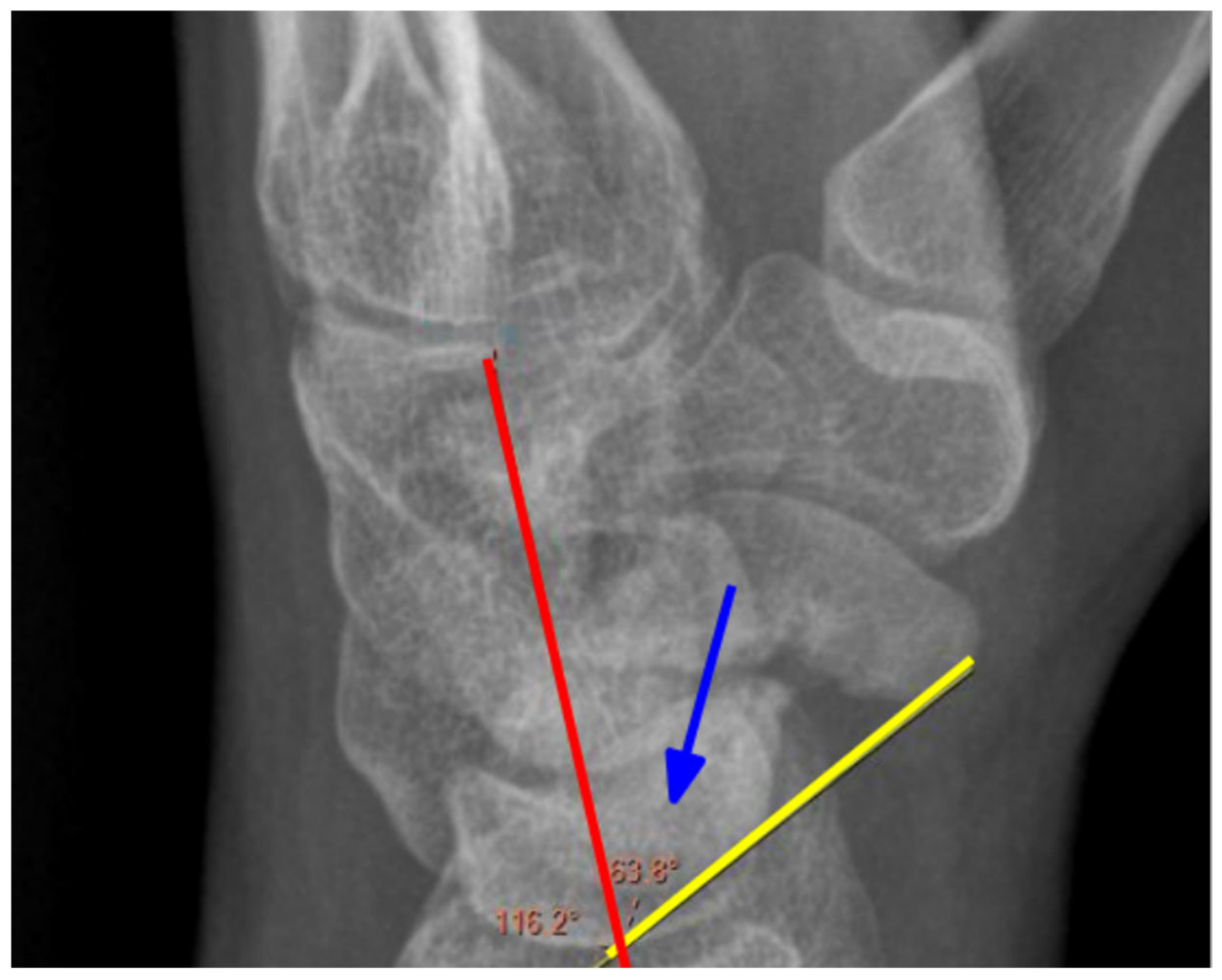
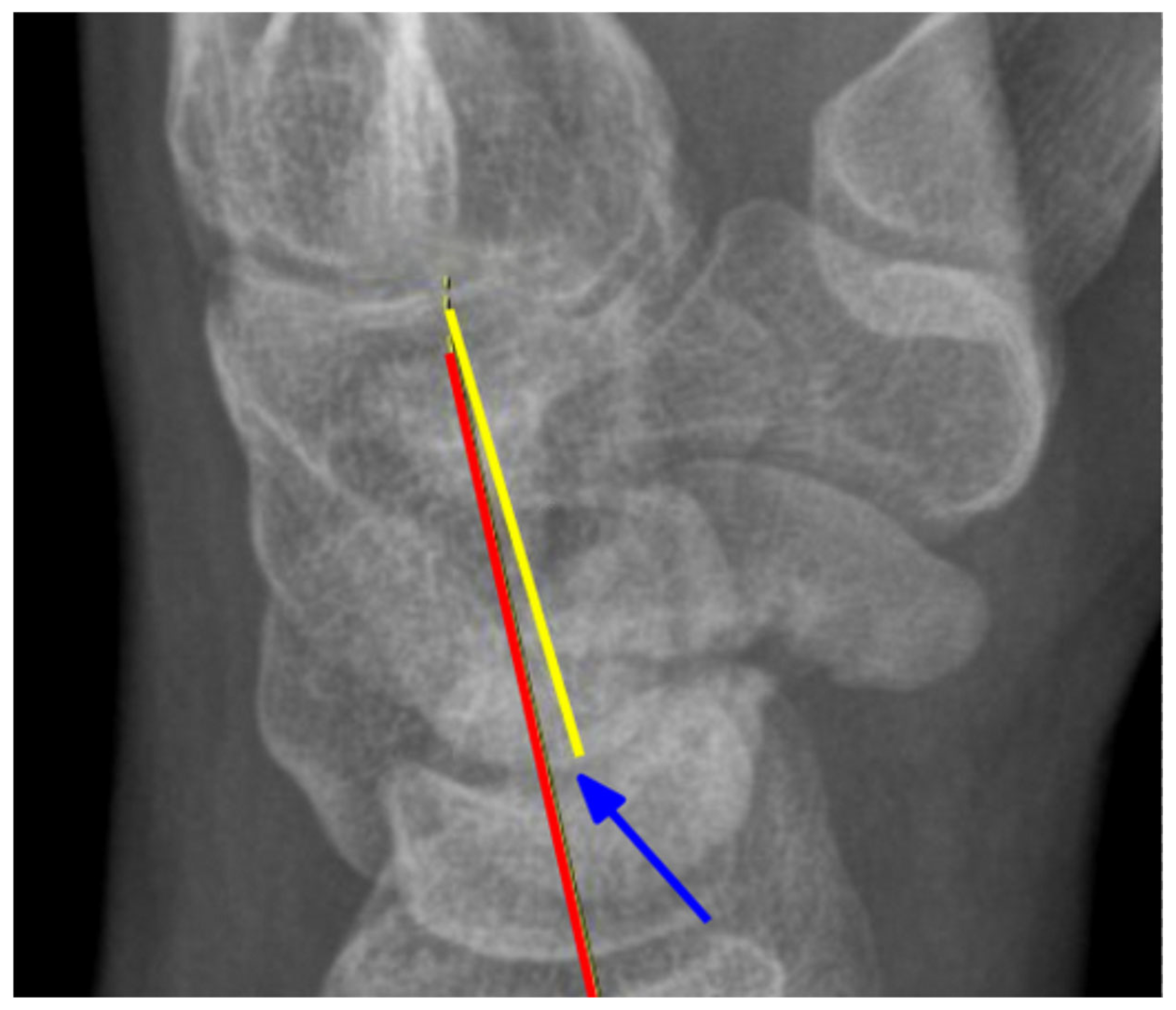



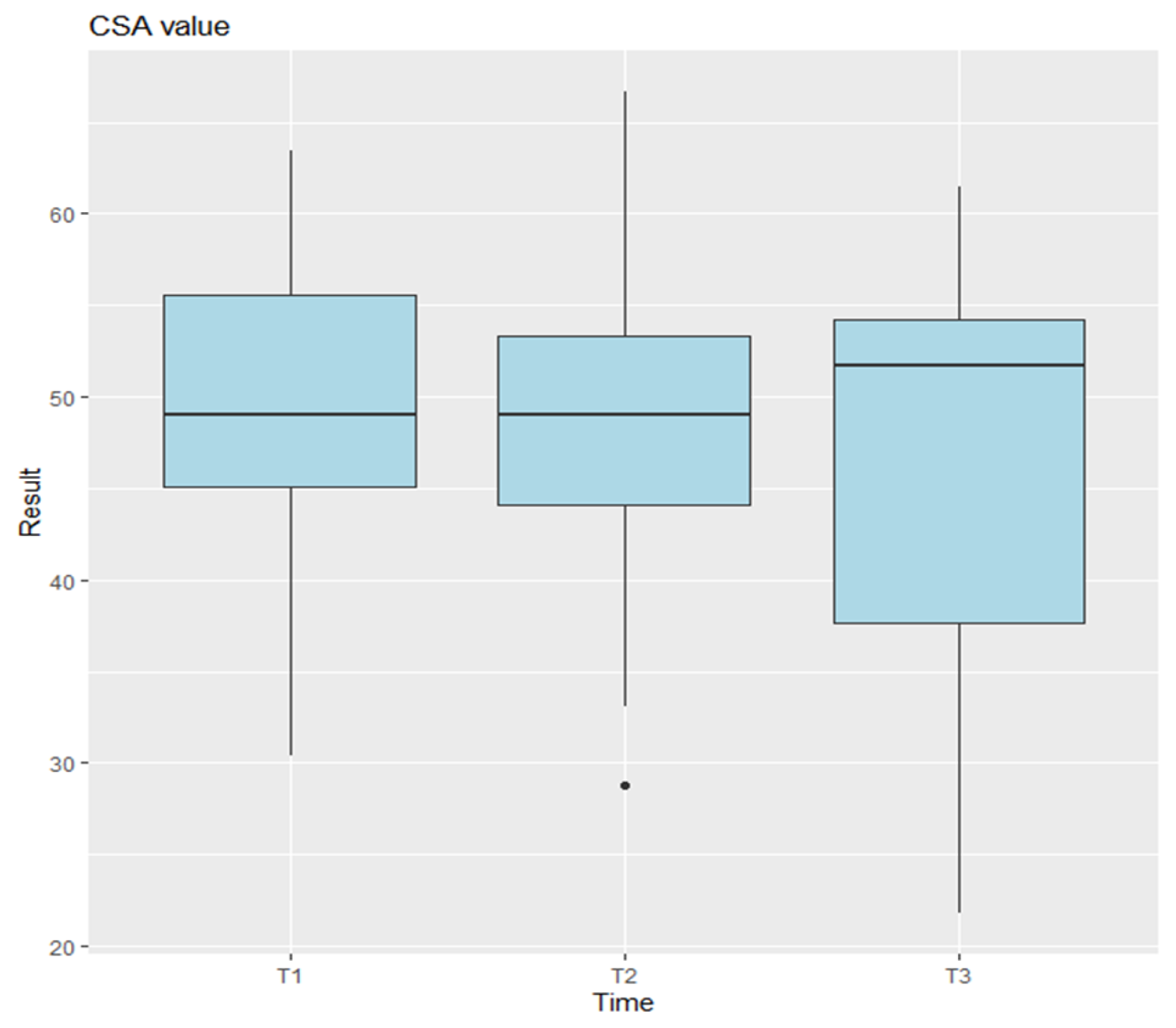
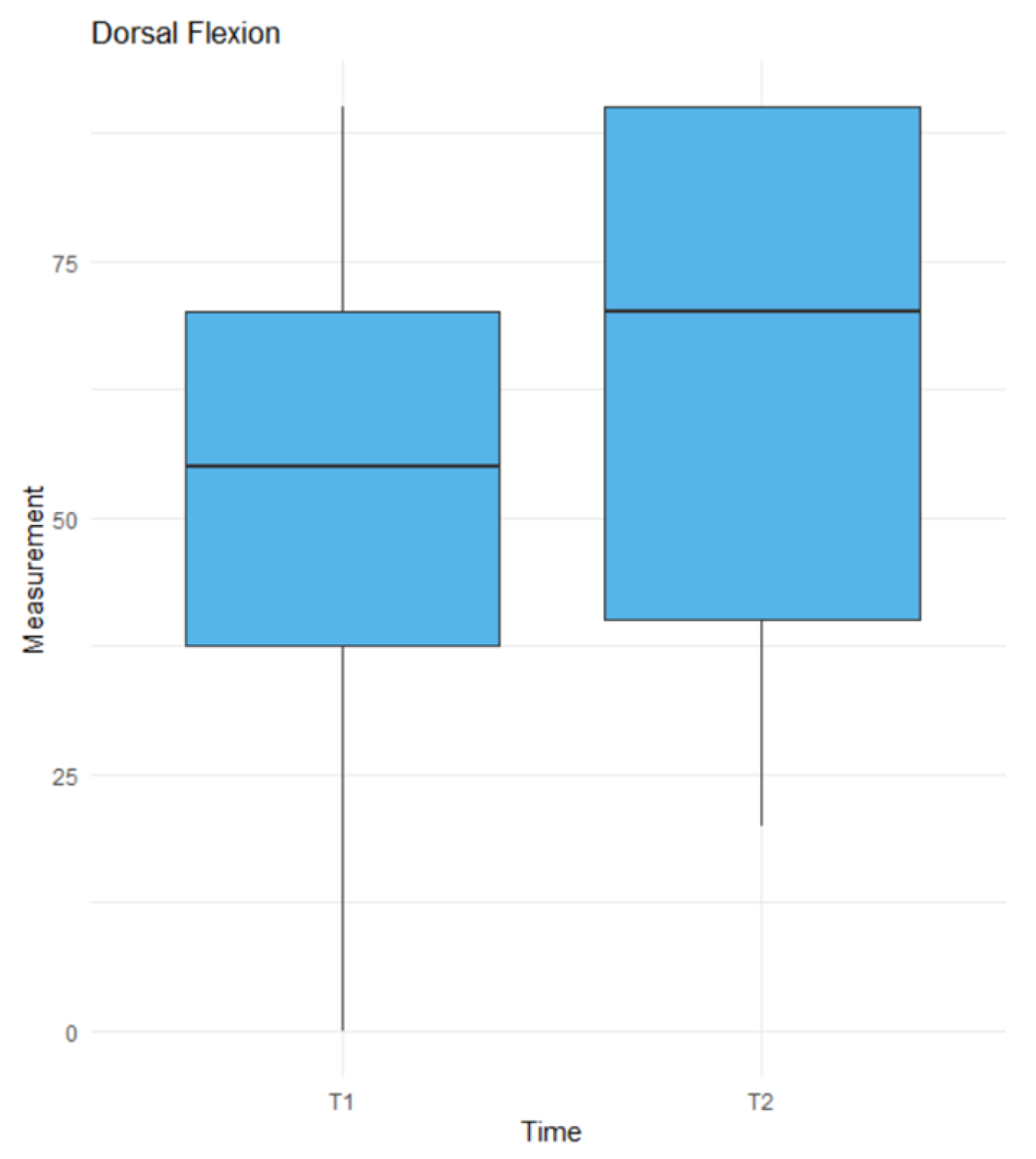
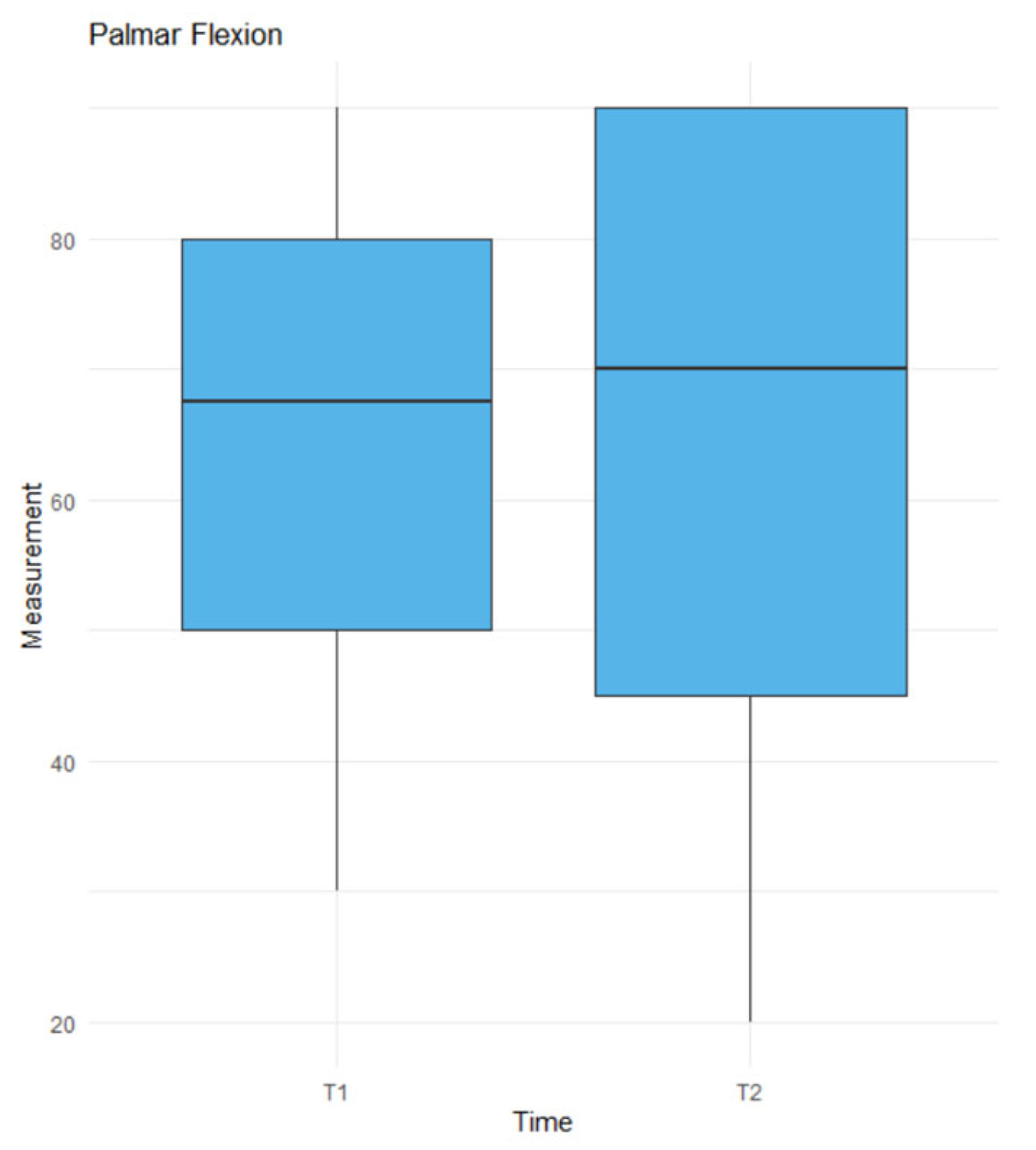
| Variable | Estimate | Std. Error | t-Value | p-Value | Significance |
|---|---|---|---|---|---|
| (Intercept) | 205.9359 | 69.2896 | 2.972 | 0.0178 * | * (p < 0.05) |
| CLA1 | 2.4792 | 0.9384 | 2.642 | 0.0296 * | * (p < 0.05) |
| SCA1 | −0.6847 | 1.5438 | −0.444 | 0.6691 | ns |
| SLA1 | −4.3850 | 1.3361 | −3.282 | 0.0112 * | * (p < 0.05) |
| CLA2 | −1.0177 | 0.9340 | −1.090 | 0.3076 | ns |
| SCA2 | −1.3195 | 0.6013 | −2.194 | 0.0595. | (p < 0.1) |
| SLA2 | 1.9726 | 0.9168 | 2.152 | 0.0636. | (p < 0.1) |
| CLA3 | 1.2620 | 1.1868 | 1.063 | 0.3187 | ns |
| SCA3 | 3.3003 | 1.5947 | 2.070 | 0.0723. | (p < 0.1) |
| SLA3 | 0.8874 | 0.6099 | 1.455 | 0.1837 | ns |
| Age | −3.5748 | 3.2291 | −1.107 | 0.3004 | ns |
| Time | −2.4581 | 0.7445 | −3.302 | 0.0108 * | * (p < 0.05) |
| Variable | Estimate | Std. Error | t-Value | p-Value | Significance |
|---|---|---|---|---|---|
| (Intercept) | 1.454671 | 1.537874 | 0.946 | 0.372 | ns |
| CLA1 | 0.019640 | 0.020829 | 0.943 | 0.373 | ns |
| SCA1 | −0.018726 | 0.034264 | −0.547 | 0.600 | ns |
| SLA1 | −0.029030 | 0.029654 | −0.979 | 0.356 | ns |
| CLA2 | 0.008902 | 0.020730 | 0.429 | 0.679 | ns |
| SCA2 | −0.010100 | 0.013346 | −0.757 | 0.471 | ns |
| SLA2 | 0.025260 | 0.020347 | 1.241 | 0.250 | ns |
| CLA3 | 0.029833 | 0.026341 | 1.133 | 0.290 | ns |
| SCA3 | 0.035614 | 0.035394 | 1.006 | 0.344 | ns |
| SLA3 | 0.007634 | 0.013537 | 0.564 | 0.588 | ns |
| Age | −0.078227 | 0.071669 | −1.091 | 0.307 | ns |
| Time | −0.015265 | 0.016523 | −0.924 | 0.383 | ns |
Disclaimer/Publisher’s Note: The statements, opinions and data contained in all publications are solely those of the individual author(s) and contributor(s) and not of MDPI and/or the editor(s). MDPI and/or the editor(s) disclaim responsibility for any injury to people or property resulting from any ideas, methods, instructions or products referred to in the content. |
© 2025 by the authors. Licensee MDPI, Basel, Switzerland. This article is an open access article distributed under the terms and conditions of the Creative Commons Attribution (CC BY) license (https://creativecommons.org/licenses/by/4.0/).
Share and Cite
Koschel, P.; Kaczmarek, L.; Woźniak, J.; Czarnecki, P.; Romanowski, L. Clinical and Radiological Evaluation of Surgical Treatment Outcomes in Disturbances of Scaphoid Bone Fusion in a Pediatric Population. J. Clin. Med. 2025, 14, 3758. https://doi.org/10.3390/jcm14113758
Koschel P, Kaczmarek L, Woźniak J, Czarnecki P, Romanowski L. Clinical and Radiological Evaluation of Surgical Treatment Outcomes in Disturbances of Scaphoid Bone Fusion in a Pediatric Population. Journal of Clinical Medicine. 2025; 14(11):3758. https://doi.org/10.3390/jcm14113758
Chicago/Turabian StyleKoschel, Piotr, Leszek Kaczmarek, Jakub Woźniak, Piotr Czarnecki, and Leszek Romanowski. 2025. "Clinical and Radiological Evaluation of Surgical Treatment Outcomes in Disturbances of Scaphoid Bone Fusion in a Pediatric Population" Journal of Clinical Medicine 14, no. 11: 3758. https://doi.org/10.3390/jcm14113758
APA StyleKoschel, P., Kaczmarek, L., Woźniak, J., Czarnecki, P., & Romanowski, L. (2025). Clinical and Radiological Evaluation of Surgical Treatment Outcomes in Disturbances of Scaphoid Bone Fusion in a Pediatric Population. Journal of Clinical Medicine, 14(11), 3758. https://doi.org/10.3390/jcm14113758






